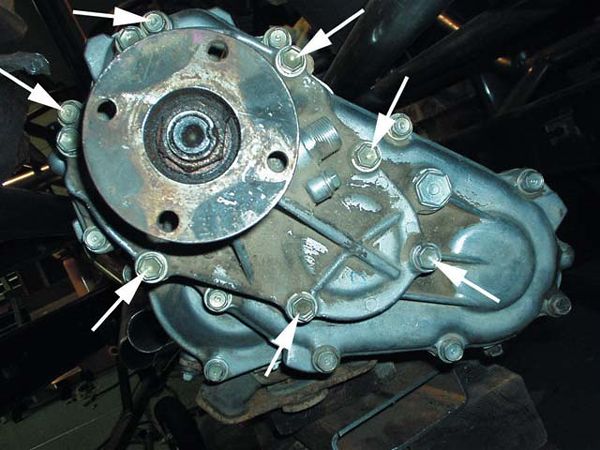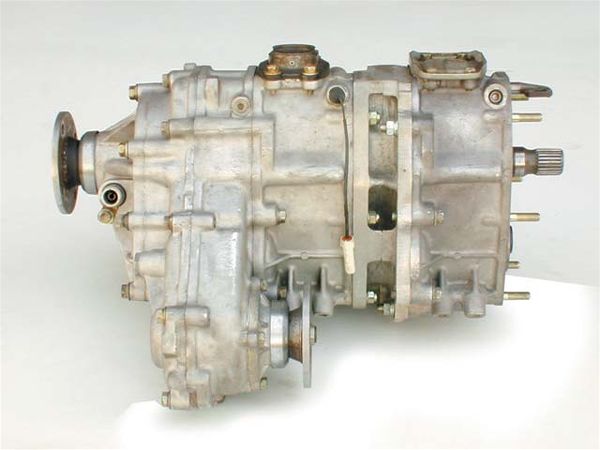
By now, plenty of 'wheelers have discovered the versatility and durability of Toyota trucks and 4Runners. These sturdy four-wheel-drive vehicles have proven their prowess over a wide variety of terrain. However, for those wanting to push the limits of what they can do with their Toyotas, the aftermarket supply of parts for these rigs has exploded over the past few years, and parts now are available to turn a Toyota 4x4 into a hardcore 'wheeling machine.
As tire size grows, so does the strain on your rig's drivetrain. The well-known Achilles' heel of the straight-axle Toyota are the Birfield joints in the front axle. Upgrade kits are available, but some 'wheelers choose to forego such a modification and simply swap in beefy domestic solid axles to handle hardcore 'wheeling.
But as often as axles, engines, and trannies are swapped out of Toyotas for bigger and badder components, the stock transfer cases live on in many of these rigs. Why? Simply put, the transfer cases found in most Toyota trucks and 4Runners are stout and reliable.
 If you have seven bolts in the rear cover (as this case has), then you have a gear-drive transfer case. If you have five bolts in the rear cover, you have a chain-drive case.
If you have seven bolts in the rear cover (as this case has), then you have a gear-drive transfer case. If you have five bolts in the rear cover, you have a chain-drive case.
From 1979 through '95, many Toyota trucks and 4Runners used a gear-drive transfer case: model RF1A. Beginning in 1984, a chain-drive transfer case of lighter design was also used in Toyotas with automatic transmissions, and from 1988 on, in V-6-powered vehicles. All V-6 models use the chain-drive case, while those trucks with four-cylinder engines come with either style, depending on type of transmission. While the gear-drive Toyota transfer case is more desirable from a standpoint of strength and reliability, both styles are quite robust and able to withstand considerable abuse.
Subtle bearing and gear changes have been made in some of the units from year to year, but only three basic low-range ratios have been offered-2.28:1, 2.57:1, and 2.66:1. The high range on all Toyota transfer cases is 1:1.
The gear-drive, or counter-gear, transfer cases have a 2.28:1 low-range gear ratio and use a 21-spline input shaft. The Toyota transfer cases used in the manual-transmission turbocharged trucks also have a 2.28:1 ratio, but have a stronger 23-spline input shaft. Turbocharged 4Runners were built only with automatic transmissions. These and other automatic-transmission Toyotas use electronically controlled transfer cases with a 2.66:1 low-range ratio. These use a special viscous coupling system at the inputs to couple and release power to the drivetrain based on road conditions. Chain-drive cases used on V-6-equipped trucks have a low-range ratio of 2.57:1 and 23-spline input shafts. These VF1A cases are also called planetary gear cases.
In 1986, along with the introduction of independent front suspension, the automatic-transmission transfer case was changed so it could be shifted from 2-high to 4-high on the fly. Then in 1989, Toyota introduced the 4WDemand system on some models. This system allows the driver additional ability of shifting from 4-high to 4-low at slow speeds.
Some of the later-model transfer cases also incorporate a small transfer case oil cooler that is plumbed into the rear of the case. On the Tacoma and newer 4Runners, the front driveshaft output is on the driver side, but is on the passenger side on older models.
 Here is a side view of a stock transfer case combined with a dual-case conversion adapter and the additional stock reduction box. This setup requires shortening the rear driveshaft and lengthening the front driveshaft, an aid for the steep front driveshaft angle on a lifted truck.
Here is a side view of a stock transfer case combined with a dual-case conversion adapter and the additional stock reduction box. This setup requires shortening the rear driveshaft and lengthening the front driveshaft, an aid for the steep front driveshaft angle on a lifted truck.
Over the years, the Toyota gear-drive transfer cases have come with two different shifter styles. There was the top-shift style, with the shifters exiting the top of the Toyota transfer case reduction box, and there was the forward-shift style, with the shifters exiting from the top of the transmission tailhousing. Early models from 1979 to late '83 were top-shift, and used a slightly weaker, noisier gear design than later models. In the 1984 model year, Toyota upgraded the transfer case to a quieter gear design with the addition of a sub-gear and thrust washer on the counter-gear.
Carbureted models from about 1984 to '87 used forward-shift-style transfer cases, as did most all models starting about 1989 (trucks) and 1990 (4Runners) onward. Marlin Crawler sells a kit to convert forward-shift models to top-shift style, as needed for aftermarket dual-case or adapter kits.
The speedometer-drive gear (or electronic speedo sender for some years) for Toyota trucks lies in the transfer case. Unfortunately, unlike many domestic trucks, the speedometer gear cannot be changed to compensate for gearing and/or tire changes. Only an outboard speed converter can be used to recalibrate the speedometer on trucks with a cable.
Gear Upgrades
Though the Toyota transfer case is a solid performer, there are still some modifications that will improve its gear capabilities. The biggest advantage of lower gearing is that obstacles can be traversed with much greater control. This, in turn, places less stress on driveline components.The first type of these low-range conversions is what is referred to as a dual-case setup. The Toyota transfer case has two major sections: the front reduction box that selects between high and low ranges, and the rear portion that selects between two-wheel-drive and four-wheel-drive.
In a dual-case setup, a machined aluminum adapter plate mates a second gear-reduction box to the front of the gear-reduction portion of the stock transfer case. This takes the stock 2.28:1 ratio and adds an additional 2.28:1 ratio gearset to provide a final ratio of 5.2:1. With such a setup you get a high- and low-range ratio for each of the two reduction boxes. With this you get 15 forward gears with transfer case ratios of 1:1, 2.28:1, and 5.2:1. You also have the advantage of running in two-wheel-drive low range by shifting only the forward transfer case into its low range.
Such a conversion does require some additional modifications to the truck, along with the transfer case modifications. Another hole must be cut in the cab floor to accommodate the additional transfer case shift lever. Also, the rear driveshaft must be shortened about 6 inches and the front driveshaft lengthened by an equal amount.
The second type of low-range conversion simply involves replacing several of the internal reduction-box gears. In this case, the high range still remains at 1:1, but the low range is reduced to 4:1, or with some kits, a whopping 4.7:1. This more than doubles your low-speed crawl torque and allows walking over difficult obstacles with much more smoothness and control.
Installing the replacement gears requires disassembly of the transfer case. However, only the transfer case modifications are needed and no further modifications to the truck are required. Since only the internals of the transfer case are modified, it is not necessary to modify the driveshafts or any other parts of the truck. For even lower ratios, consider combining a dual-case conversion with a set of lower-range gears.
Note that both dual-case conversions and low-gear conversions are available for use only with the gear-drive transfer cases. This is fine if you have a four-cylinder five-speed. But what about those with automatic transmissions, V-6 engines, or a new Tacoma truck? Marlin Crawler has come up with solutions to address most of these configurations.
In addition to its Ultimate kit, Marlin Crawler has dual transfer case kits and low-range gear kits available for all V-6 3.4L Tacomas with automatic or manual transmissions. For Tacomas with a swapped-in straight axle, both right-hand-drive and left-hand-drive conversion components are available. At the time of this writing, four-cylinder Tacoma parts were being designed as well.
Other Upgrades
Along with the many reduction-gear options available for Toyotas, there are some other interesting upgrades. One of these upgrades is the Twin-Stick Conversion Kit available from Front Range Off-Road Fabrication. The stock transfer case uses a single shift lever to move two shift rails inside the transfer case. One rail actuates high/low range and the other rail shifts from two-wheel drive to four-wheel drive. Possible combinations are 2-high, 4-high, and 4-low. However, there is no low-range option for two-wheel drive. Installation of a twin-stick kit provides you with one shifter to control each of the gearing and drive functions separately. With a lever shift this allows you to go from four-wheel drive to two-wheel drive in low range. This is especially useful for 'wheelers who run hard lockers in the front axle and find it hard to turn sharply when the front locker is engaged.
A unique approach to overcoming the bulky stock crossmember is this crossmember/skidplate combo from Front Range Off Road Fabrication. It requires minor welding for installation but offers clearance gains of up to 3 inches, plus firmer mounting of the entire drivetrain to reduce the habitual tearing of stock motor mounts under extreme use.
Adding lower gears and bigger tires is a natural progression to building a bigger and badder trail Toyota. However, getting a little extra ground clearance under your truck is always a good thing as well. We can even do it without adding more lift.
Toyota builds lots of its structural members from sheetmetal stampings that provide excellent strength with relatively light weight. Such is the case with the stamped and welded transfer case crossmember. Although strong, it is bulky and constitutes a low point under the frame. An easy way to gain ground clearance here is to use a replacement crossmember that provides sufficient beef without the thickness. A gain of nearly two inches in ground clearance can be had by building your own crossmember or purchasing one from one of the suppliers listed here. For belly clearance, it's almost like adding a four-inch-taller tire.
Whatever you're 'wheeling, you'll find Toyota transfer cases to be stout and reliable performers. With the wide availability of aftermarket beef-up parts and a number of stock interchange options, you can set up your truck or 4Runner to tackle any four-wheeling you may want to do.
For And Against
This table summarizes the pros and cons to using either of the two methods of gaining lower transfer case gearing.
Dual-Case Setup
Pros:
- Three transfer case ratios
- Improved front driveshaft angle
- Combines with 4.7:1 gears for the ultimate low-range
Cons:
- Requires driveshaft modifications
- Requires floorboard modifications
- Slight increase in driveline slop
Low-Gear Reduction
Pros:
- No other modifications required
- Preserves original drivetrain setup
Cons:
- Cannot pick "stock" low-range
Ratio Gains
The table below quickly summariezes the gain in the overall final-drive ration that can be gained through the use of reduction gearsets and/or dual-case conversions. Here the table assumes a common aftermarket 4.88:1 axle ratio and a 3.95:1 First gear (Toyota five-speed manual) ratio.
Transfer Case Setup Transfer Case Ratio FinalDrive Ratio Stock 2.28:1 44:1 Replacement Gears 4.70:1 91:1 Dual Cases (stock gears) 5.20:1 100:1 Ultimate Dual Cases 10.70:1 207:1 Marlin's Dual Ultimate Overkill 22.10:1 426:1











